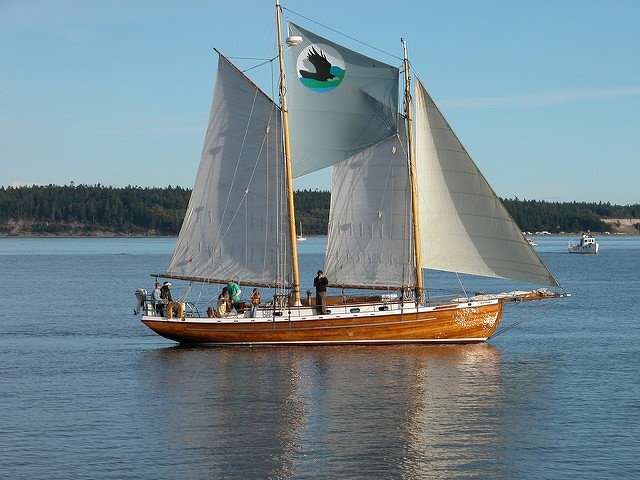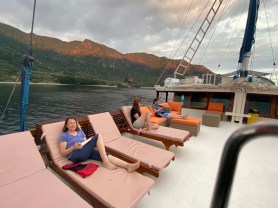

Voyager, author and engineer Peter Berman offers his best advice on buying a good, used cruiser for any sailor. Sailors wanting to buy a boat and who are ready to take the plunge — can take advantage of these tips.
Videos by Outdoors
Sailors need an affordable boat they can depend on to meet the needs of their crew and saleable itinerary. Berman intends to help you create the best cruising experience. From an owner of a dozen of different boats, sailors should check out some of this tips below if they want to make the best of their boating experiences.

TIPS FOR BUYING A BOAT
1) Remember the 30:70 rule: The builder makes 30 percent of the boat and purchases the remaining 70 percent from other suppliers, almost all of which has to be periodically replaced at ever-higher prices. The 30:70 rule helps explain high rates of depreciation — typically 50 percent after the first decade and 75 percent after the second.
2) Focus on the total acquisition costs: the purchase price plus the inevitable refit. A good rule of thumb is to use only half the boat budget to buy the boat, then employ the other half for the requisite upgrades. A common boat-buying mistake is not reserving enough money for the overhaul. Also, prepare a realistic annual maintenance budget before the purchase. A boat stuck on the dock provides no joy.
3) Avoid being beguiled by a long list of equipment and cosmetic touch-ups. Fact: Most equipment will probably require replacement. Also, brokers and sellers know that cosmetics help sell boats, but they don’t make them sail any better. Similarly, view claims of a “recent refit” with skepticism. Does new anchor chain or new sails make the boat worth more when chain and sails are part of a boat’s normal complement of gear? (And that actually may be a “yes” when it comes to sails, but rarely will you find a used boat with a new inventory.)
Related Stories: How to Repower Older Boats
4) The major refit costs will likely involve the rig and engine. After 15 to 20 years, it’s long past time to pull the mast, upgrade the standing rigging and terminals, take apart the spar and inspect for crevice corrosion and cracks, replace blocks, inspect the sheaves and mast step, and beef up gear as necessary. For extended offshore use, the general rule is to replace everything with heavier rigging and equipment. Losing a mast offshore makes for a very bad day. Paint makes masts look better but often hides corrosion.
5) Likewise, after two decades, it’s time to pay the “engine piper” — or pay him later. There are basically two options: rebuild what’s already installed (saving half the cost) or repower with a new engine. Typically, the in-and-out labor costs are equal to the cost of a rebuilt or new engine. Changing engine brands can significantly add to the price. Remember, many experienced cruisers cover as many as half their miles under power (especially those running up and down the Intracoastal Waterway). So a reliable engine is essential. No one ever complains when it starts up every time! Also, budget for ample spare parts; obtaining them in distant ports can be a real headache.
6) Nothing improves comfort more than size. Within limits, everything on the boat can be changed except size. But size is a double-edged sword, as costs and maintenance even in slightly larger boats are disproportionately higher. As size increases, so does volume. A 40-footer will have twice the volume of a 30-footer. When discussing size, focus on the waterline length. Length matters because size yields more storage space and more accommodations, and longer boats tend to sail faster, with a smoother motion. Bigger boats also provide the ability to take on additional crew for longer passages.
Related Stories: 5 Boat Anchoring Tips for Deep Water Fishing
7) With the right gear, including electric winches for furling mains or halyards, a senior couple in reasonably good condition can take a 60-footer offshore. But the maintenance and operating costs of such a vessel can approach six figures yearly. Most cruising is done in affordable vessels in the 40-foot range, where traditional gear gets the job done. All that said, when cruising really took off in the 1960s and 1970s, a 25-foot fiberglass production boat was often considered big enough for offshore work.
8) As mentioned at the outset, there’s no such thing as a perfect cruising boat, no matter how large the budget. Moreover, one’s notion of an ideal cruiser changes with experience, intended usage and age. Boats are always works in progress. Center cockpits with island double berths have nice accommodations for dockside use. For offshore sailing, on the other hand, and especially if they eschew island doubles for snug sea berths, aft cockpits enhance the sailing experience. Jib furlers and electric winches make life easier but also can introduce cost and maintenance issues. Everyone underestimates the cost of owning and operating a functioning cruising boat.
9) Beware of fancy joiner work and the liberal use of external teak. It’s nice to look at, but it doesn’t make the boat perform any better and is costly and/or time-consuming to own and maintain. Similarly, unless you have deep pockets, avoid teak decks. (Teak is lovely, but it’s also awfully hot in the tropics.) Whether screwed or glued, after 15 years, teak decks are typically ready for replacement, nowadays at a cost that would buy a nice cruising sailboat.
Related Stories: Speedboat blasts record breaking wall of water at 262 mph
10) Given the choice, opt for a boat drawn by a reputable naval architect over one from a builder who designed his own boats. I’ve found that the collaborative efforts produce better boats. Pay special attention to designers and builders who focus on cruisers, not raceboats. When you’ve narrowed down a prospect, learn about the boat’s history, talk to owners of similar boats and experienced surveyors, and, when applicable, contact the club associations of respective models, which can be good sources of information. Whatever you’re considering, remember that a boat that’s “lived in the islands” is apt to have had a hard life.
11) If you’re truly considering long-range cruising, think long and hard about the boat’s accommodations for use offshore. Double berths in the bow or stern are wonderful in port, as are swivel chairs in the main saloon. Without functional sea berths amidships, however, the crew will wind up sleeping on the cabin floor and asking when the trip will be over. Any sea berth worthy of its name is a minimum of 7 feet long and has a proper lee cloth.
12) Like Napoleon’s armies, crews travel on their stomachs. Spacious galleys are fine alongside a dock, but at sea you need a galley where the cook is secure and the pots and pans stay off the cabin sole. If you really want to eat well offshore, nothing beats a large freezer or crews handy with a rod and reel.
13) Marine toilets can and do fail, usually at the most awkward time. Spares help, but a second head is better. Repairing a head when underway is probably the worst job afloat.
14) Regardless of your budget or the size of your vessel, take safety seriously. That means a certified ocean life raft, EPIRBs, SOLAS-rated and -equipped life jackets with harnesses, a VHF radio with AIS, ample bilge pumps and even a sat phone if voyaging offshore. Before loading up on electronics, cover the safety gear. Sure, it’s nice to have an SSB radio, a big-screen chart plotter, an autopilot, a TV, a Wi-Fi router and so on. But buy the life raft first — if not for yourself, then for your crew and loved ones (even if they’re not sailing with you).
Related Stories: Amazing footage captures largemouth bass eating a GoPro camera
15) When in doubt, walk away. Unless the boat inspires real passion, it’s the wrong boat. Find the most competent and highly regarded surveyor available. Ask him or her about the required refit and likely costs involved. I’ve never regretted walking away from, or spending the money on, a “problem” survey. Make sure you have a serious sea trial — and not just a short run with the engine, and a quick raising and lowering of sails — in a good breeze. Even very experienced sailors can fail to note the obvious on sea trials, especially rushed ones.
Related Stories: Bass fishermen try and take on the goliath grouper
For more information, visit crusingworld.com.








